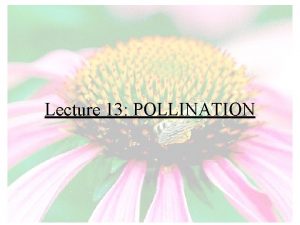Pollination Partnerships Fact Sheet Have you noticed the


- Slides: 2

Pollination Partnerships Fact Sheet Have you noticed the fantastic differences in flower shape, color, and smell? Variation is the working material for evolution. Flowering plants (angiosperms) Cactus, lily, trillium, larkspur, Jack-in-the-pulpit, four-o’clock, trout lily, orchid, magnolia, onion, & Dutchman’s pipe in FNA vols. 3, 4, 22, 26. Art by J. Myers, B. Alongi, Y. Wilson-Ramsey. evolved more than 100 million years ago. Competition for animal pollinators helped to drive the diversity of flower forms we see today. Plants attract animals with colorful, fragrant, and showy flowers and offer visitors a reward, usually pollen or nectar. Why do flowering plants need animal partners? Rooted in place, plants rely on wind, water, & animals to move pollen from anthers to stigmas. Up to 90% of flowering plants are pollinated by animals. Who are the pollinators? Bees, butterflies, and moths do the lion’s share of pollination. But many animals, even mosquitoes and mammals, pollinate flowers. Their lifestyles and adaptations influence the kinds of flowers visit, and the rewards they receive. How do animals differ in when and how they search for food? Beetles – good vision (some color vision) and good sense of smell, use short mouth-parts to eat nectar &/or pollen while standing on flower Moths – good sense of smell (prefer sweet scents), probe for nectar while hovering Bats – good sense of smell (prefer musky scents), use a long, feathery tongue to reach nectar &/or pollen Flies – good sense of smell (prefer rotten scents), get no food reward Flies – good color vision and sense of smell, collect nectar &/or pollen Butterflies – good color vision but poor sense of smell, collect nectar while standing on flower Bees – good color vision (see into UV range) and sense of smell, collect nectar &/or pollen while standing on flower Birds – good color vision but poor sense of smell, use long beak to reach nectar; specialized nectar feeders like hummingbirds hover while feeding Make a prediction! Which kinds of flowers and animals are partners in pollination?

Pollination Partnerships: Yucca and Yucca Moth page 2 Loose fit / tight fit –– Are partnerships general or special? Most plants have several pollinators. One-to-one matches between plant and pollinator species are rare. North America is home to a case of tight coevolution in pollination systems: the yucca and yucca moth. Any time animals visit flowers for a reward and carry pollen between flowers, both the animals and plants benefit (mutualism). Yucca are pollinated only by yucca moths, and 70% of yucca moth species visit flowers of only one yucca species. The yucca and yucca moths depend on each other for survival. These obligate interactions are up to 40 million years old. If adult yucca moths do not eat pollen, how do both the moth and plant benefit? A female moth has special mouth parts (tentacles) for collecting pollen. She balls up the pollen and stores it under head. The pollen is sticky and clings as she flies between yucca plants. Yucca elata David Bogler Yucca belong to the plant family Agavaceae (~50 species in the genus Yucca and 3 species in Hesperoyucca). Yucca moths are in the family Prodoxidae of the order Lepidoptera (15 species of Tegeticula and ~4 species of Parategeticula). Most species of yucca and yucca moth occur in deserts of the Southwest, but stretch from grasslands to pine-oak woodlands. Coevolution: complementary evolution of two species that interact closely and influence each other’s adaptations Mutualism: (+ / +) Tegeticula David Bogler She reaches a fresh flower interaction that benefits both and actively packs the species pollen on the stigma, pollinating the yucca. Obligate mutualism: Then, she moves to the interaction that is both flower base and lays her beneficial and necessary for eggs (oviposits) in the both species ovary. Finally, she climbs up to the anthers and collects pollen, ready to repeat the process in a new flower. When her larvae hatch inside the fruit, they feed on the ripening seeds. Rare but repeated! The senita cactus (Pachycereus schottii) and senita moth (Upiga virescens), found in Sonoran Desert of Arizona and Mexico, have an obligate pollination system very similar to the yucca and yucca moth. Pollination Partnerships Fact Sheet by Claire Hemingway, Ph. D. © 2004 Flora of North America Association



